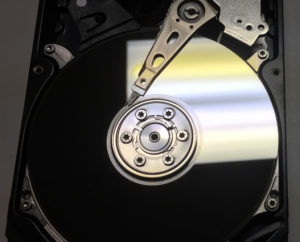
The exposed platters of a hard drive.
Before performing logical data recovery procedures on a hard disk drive (HDD), engineers always create a complete clone or image of the drive.
This is an essential step: Without a clone/image, data recovery processes — even when carried out properly — might cause permanent data loss under certain circumstances.
To understand why, let’s quickly explain the terms:
- A hard drive clone is an exact sector-by-sector duplicate of one drive onto a second physical hard drive. In other words, you create an identical version of the primary hard drive by using a second HDD.
- A hard drive image is also an exact sector-by-sector duplicate, but to a logical volume (a file).
- A hard drive copy duplicates all of the partitions or files from one drive to another (or to a logical volume). A copy is not a sector-by-sector duplicate.
With a clone or image, engineers can perform as many logical (software-based) repair processes as needed by using the duplicate. They have more chances to repair the damaged files, so the chances of a successful case result are higher. Without a clone/image, the engineers would only have one chance to repair the target data.
Why isn’t a hard drive copy as useful as a clone/image?
A hard drive copy is only useful if the file table is in excellent shape and all of the data is fully functional — and if you’re restoring data from a damaged HDD, that’s rarely the case.
A sector-by-sector clone or image is essentially identical to the repaired drive. That’s assuming that physical repairs were successful — all issues (such as read/write head failures) must be resolved before the clone/image is created.
Do you need to clone a healthy hard drive before performing data recovery?
Yes, absolutely. This is standard practice within the industry for several reasons:
- A hard drive might have issues that were missed or that weren’t detectable during the evaluation.
- Any hard drive can fail at any time, and a “healthy” drive might fail during logical recovery procedures.
- Cloning/imaging doesn’t take long or require much manual oversight, so it doesn’t add to the cost of data recovery.
Most laboratories will clone/image all other types of media, too. That includes solid-state drives (SSDs), thumb drives, RAID arrays, and even floppy disks.
Related: When Should You Clone a Hard Drive?
My hard drive failed. Should I make a clone/image of the drive?
No. If your hard drive has failed, attempting a clone/image could cause permanent, irreversible damage. Read/write head failures and other physical issues must be fully resolved before cloning. Engineers perform these repairs in certified cleanrooms to prevent platter contamination — you cannot safely repair a modern hard drive at home, and your local computer store won’t have the necessary resources.
If you’re 100% sure that your hard drive has logical (non-physical) issues, you can clone it. Here’s our guide to creating a clone by using ddrescue.
However, because of the high relative risk, we strongly recommend seeking professional help before running any software. If your data is irreplaceable, you might only have one chance to recover your files; a reputable data recovery provider can optimize your chances of a successful result.
Datarecovery.com provides risk-free evaluations, and we support all of our services with a no data, no charge guarantee: If we’re unable to recover the files you need, there’s no charge for the attempt.
We operate fully outfitted laboratories at each of our offices. To learn more, call 1-800-237-4200 or schedule a free evaluation online.




